The Kanadorikan Empire (Hvidovian: ᚴᛆᛀᛆᛑᚮᚱᛋᚴᚮ ᚼᛂᛁᛘᛋᚡᛂᛚᛑᛁᚧ / Gugtonese: 카나다도 칸 제국) (also known as the Third Kanadorikan Empire) is a multinational empire with territories across the globe. The Empire consists of eight individual nations which together form the union that is Kanadorika; Hvidovia, Northurland, Hameentra, Leirhofn, West Akrifa, Gulland, Kuwang, and Oceania. The largest and most populous of these is Hvidovia. Other territories of the Empire include Krofluhellir, New Halfjord and, Ekjaldr. The nations are further divided into sub administrative units. Hvidovia, Leirhofn, and Hameentra utilize cantons, whereas Northurland and Osmanlı uses provinces to administer different parts of the nation. The Commonwealth of Oceania is divided into Dominions, with Viktoria being the most prominent.
Kanadorika is a parliamentary monarchy. Power is vested in the Empress, who shares her responsibility with the Parliament, the Prime Minister, and the Lord Konsul to enact legislation. Kanadorika has two capital cities, Venesia, which is home to the House of Commons and the imperial throne, and Fljóthøfn, which is home to the Senate and the Supreme Court of Kanadorika. Brautarhólmur is the largest city in the Empire and also the largest city in the world.
Kanadorikan history is marked by multiple prominent eras and governments, including the First Empire (1081-1763), the Commonwealth of Kanadorika (1763-1803), the Second Empire (1803-1918), the Republic of Kanadorika (1919-2017) and the current government, the Third Empire of Kanadorika. The Second Empire was the largest empire in global history, encompassing more than a quarter of the world and dominating global affairs. Today, Kanadorika has the largest economy in the world with a GDP of ᚠ33 trillion. The national language of Kanadorika, Hvidovian, is the de facto lingua franca, and is spoken across the world in former Kanadorikan colonies. Kanadorika was the first nation in the world to industrialize, beginning in the 18th century, and was the first nuclear power, developing atomic weapons in 1945. Kanadorika remains a superpower, with extensive economic, cultural, military, scientific and political influence internationally. Domestically, the Empire supports a high human development index rating, and is a high income economy.
Kanadorika is a founding member of the Kanadorikan Commonwealth, an organization consisting of former territories, and is a founding member of the League of Etharian Nations, presiding over the Security Council and hosting the LEN headquarters in Brautarhólmur.
Etymology
The name origin of the word "Kanadorika" stems from a term meaning "universal realm" during the high middle ages. When the Hvidovian Kingdom conquered its neighbors, the resulting empire as a whole became known as Kanadorika.
History
Early History
Eyjanic people have lived on the continent of Eyjan since at least 4000 BC. By the 9th century BC, the Venesian Kingdom was a flourishing (but small) power located on the island. It would grow in size and power over the centuries, and would be the ancestor to the Kanadorikan people and language who would come a millennium later. Northurland, by contrast, is home to the Gugtonese people.
Classical
The Venesian Kingdom would go on to be the predominant power in Northern Etharia, becoming the Venesian Republic in 502 BC. By the First Century BC, it would conquer territory in western Eporan. The leader of Venesia was given the title of Imperator (meaning king of kings, or emperor) and the Kingdom became officially known as the Venesian Empire. This put it into direct contact with the people residing in the lands referred to as "Trekká" (now modern day Treko). The Trurik people of western Trekká would stage multiple raids and ambushes on Venesian forces at the border. By 453 AD, the problem had grown so pervasive that an invasion of Trekká was made. The invasion would ultimately cost Venesia control of its empire, with the war lasting decades and depleting treasury. Finally, in 520 AD, the empire collapsed in Eyjan When Emperor Iovius IV abdicated from the throne, sending Eyjan into the dark ages.
Nevertheless, the Venesian Empire continued to exist in what is today Geitland, and the new capital of the Empire would move here and continue to rule for another 500 years.
Dark Ages
After the Venesian Empire collapsed, its former lands would come to be controlled by the tribes who were formerly subjects of the Venesian crown. Several peoples, notably the Hvidoveds and Hofnians, would fully embrace Christianity whereas other tribes reverted to Paganism. The Hvidoveds themselves moved into former Venesia, taking up their culture and language.
Approximately one hundred years later in 650 AD several tribes centralized into a number of monarchies. These included the Hvidovian Kingdom, Darkurian Kingdom, Grand Duchy of Hudiksa, Gerishian Kingdom and the Hofnian Kingdom. The Homarian peoples in eastern Eyjan remained tribal in nature.
Middle Ages
Unified Kingdom
In 798 AD, King Sigurðarson of Hvidovia began his two year conquest of the mainland Eyjan tribes which had existed independently since the fall of the Kingdom. When he succeeded in 800, he was declared Emperor of Eyjan, and created a kingdom which for the first time unified the island since Venesian times. The island of Hameentra remained independent from Sigurðarson's rule.
Sigurðarson's Empire was nevertheless short lived. Upon his death in 813, his lands fell into disarray and chaos, and new kingdoms were established. These were Leirhofn, Sauðárkur, and Kvínsur. Hvidovia continued under a new dynasty. Despite its short existence, the Empire of Eyjan's greatest legacy was the full Christianization of the Eyjanic peoples. Paganism was extinguished on the island and only continued on in Hameentra.
Four Kingdoms
Medieval Kanadorikan Empire
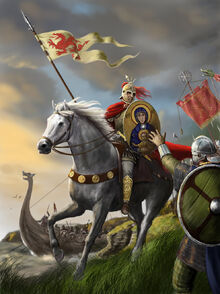
King Sigurðarson's Conquests
These four kingdoms would remain relatively stable until the coronation of Ludvig the Great, as King of Hvidovia in 1074. Born to King Knūt of Sauðárkur and Queen Isānoa of Hvidovia (the two married strategically, and ruled as equal partners) he inherited his parents kingdoms. Forging an alliance with the distant but friendly Kingdom of Northurland in the far west, Ludvig conquered Leirhofn, and Kvínsur by 1081. With the Northurlandic agreement to a union with the Eyjanic states, he would be crowned emperor that same year and ushered in 837 years of imperial rule. In this new empire, three of the kingdoms were left with their monarchies intact; their respective royal sovereigns ultimately respecting the imperial authority of the Emperor. The name Kanadorika would continue to describe the empire as a whole. Thus, the Emperor was actually King-Emperor, holding both the title of Emperor of Kanadorika (the empire, and King of Hvidovia. Ludvig would go on to conquer Hameentra, as well as Geitland to the east, bringing them into the Empire and putting those regions under singular rule for the first time since the Venesian Era.
The High Middle Ages was the height of feudalism in the young Kanadorika. Most power was vested in the local lords, and while the emperor did hold direct control of the Imperial Lands, which included the city of Venesia, he had to rely on vassals to rule over other lands in the Empire.
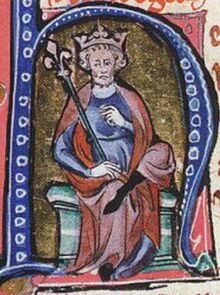
Ludvig the Great
The death of Emperor Maxim II in 1396 left the throne open, with no obvious successors. Eventually, two rival claimants would gain support by various factions throughout Kanadorika. Duke Valur of Halfjord and Baron Aslak of Nyfed would amass armies by the end of the century, and fight in what is known as the Kanadorikan war of succession.
Aslak, with the help of his loyal vassal and knight Sir Ingvi of Rødkilde, as well as teenage peasant girl turned military commander Alma of Geirsa, successfully conquered the Leirhofnian capital of Hapargård. With the support of the nobles within his own faction, Aslak crowned himself King of Leirhofn. With the entirety of the resources of Leirhofn at his disposal, Aslak conquered the city of Venesia and defeated Lord Valur, putting an end to the war. Aslak would become Emperor of Kanadorika in 1405, and the Imperial throne was moved from Venesia to Hapargård, however the Senate remained in Venesia. Upon becoming Emperor, Aslak began a series of reforms to centralize the position of Emperor of Kanadorika. The feudal system of the early and high middle ages would slowly come to an end as the Emperor gained more power.
In 1463, under the reign of Aslak's son, Emperor Aslak II, Kanadorikan Sigurvegari, who were explorer-conquerors, landed in Anphilos in what is now Lapeenkoski, and claimed land for the Kanadorikan Empire. While the existence of the New World (or at least Anphilos) was widely known among Kanadorikans for over a thousand years, this marked the first time that an expedition was sent out with the sole purpose of colonizing new land, sparking the age of exploration among the major powers of the world.
Renaissance
Commonwealth of Kanadorika
Poor leadership on the behalf of Emperor Maxim V and his estrangement of Parliament led to the Glorious Revolution in 1763. The armies of Parliament, led by Prime Minister Októvíus Kolgrímsson proved victorious against the loyalists supporters of the monarch, and on September 1, 1763, the monarchy was abolished and the Commonwealth of Kanadorika, with Kolgrímsson once again becoming the Prime Minister as well as head of state in the newly established government. As the first major Republican state in the world, the Commonwealth proved influential in spreading the ideals of liberalism across the globe, even supporting colonial Þenagach in its war of independence against Ninhundland. Alas, the assumption of Konstantínus Gústavsson into the office of Prime Minister would prove to be the downfall of republican government. Konstantínus consolidated his power and suspended parliamentary procedure. In 1803, he declared himself Emperor of Kanadorika and took the name , forming the Second Kanadorikan Empire.
Emperor Konstantínus essentially made Parliament a puppet, giving himself full power as monarch. Yet as emperor, Konstantínus maintained the egalitarian and liberal ideals of the former Commonwealth.
Industrial Era and Colonialism
Main article: Viktorian Era
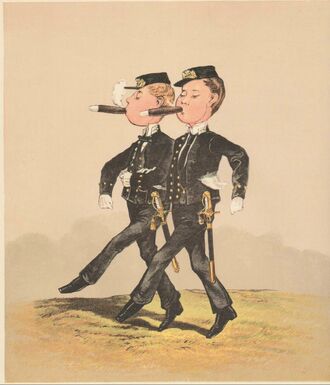
Kanadorikans during the Viktorian era saw their empire as the height of global civilization. This self righteousness and confidence influenced Kanadorikan racial theories of the era.
By the 19th century, the Kanadorikan Empire was at the height of its power. The Parliament legislated reforms after the death of Konstantínus in 1827, taking power away from the Emperor and restoring it to the elected Prime Minister and Parliament. While the monarch still held authority in various matters, the nation returned to constitutional monarchy.
In the previous century, Kanadorika began looking outwards and would establish various colonies across the world. By the 19th century, these colonies would transform the formerly concentrated Kanadorikan Empire into a major colonial superpower and the largest empire in global history, vastly surpassing even the Trekkish Empire.
Developments in technology and manufacturing quickly spread from the mainland to Kanadorika, or developed in Kanadorika outright; forever changing the lifestyle of the working class from rural farmers to urban dwellers. The cities sprang up in the interior along various river ports ports and railroad lines, becoming established centers of trade and commerce. Kanadorika was surprisingly slow to industrialize beyond Eyjan, however by 1870, industrialization had shaped Northurland and other regions of the Empire.
All this has resulted in the 19th century being known as the "Kanadorikan Century." The reign of Empress Viktoria II (1874-1886) brought a stylish young woman to the throne, forever influencing the trends of the era both within the Empire and outside. Her early death would result in her younger brother taking the throne, Emperor Víglundsson II.
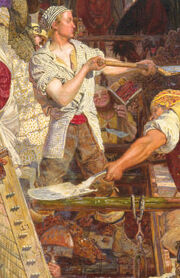
Kanadorikan laborers in 1850s Fljóthøfn.
Early 20th Century
Civil War
Main article: Kanadorikan Civil War
Emperor Víglundsson II's reign marked the rapid deterioration in the balance of responsibilies between the monarch and Parliament. He imposed his will on Parliament considerably. While this was technically legal, it went against centuries of tradition allowing for Parliament to interact independent of the monarch. Tensions would further increase until Taavi Hirvonen was elected as Prime Minister in 1913. The Emperor broke with tradition and refused to appoint Hirvonen as PM. Outraged, Parliament passed the Parliamentary Appointment Act, stripping the crown of its powers to appoint the Prime Minister. Emperor Víglundsson II refused to sign the act, with Parliament finally responding with the Abolition of the Monarchy Act and the Republican Government Act in 1914, abolishing the monarchy and forming the Republic of Kanadorika. Víglundsson II and loyalists in the minority government saw the acts as blatant treason, and on March 8, 1914, declared war on the Republic. The Republic of Kanadorika, whose support base consisted of the constituencies which elected the MPs of the Progressive Party into Parliament, declared war on the Empire of Kanadorika on the same day, thus marking the beginning of the Kanadorikan Civil War.
The Civil War was fought from 1914 to 1918, and was in effect a war between two separate states as opposed to merely being between to factions of a single state. Both the Republic and the Empire maintained considerable industral capabilities, and as such both sides were able to uniquely wage total war against one another. While the war would eventually end in a Republican victory, a consequence of Kanadorika, formerly the world's policeman, withdrawing from global affairs led to the First World War among countries in Eporan.
Republic of Kanadorika
Interwar Period
The Republic of Kanadorika was by no means a liberal republic in its first several decades of existence. The system of peerage and nobility, a carryover from the Middle Ages, continued on unchanged, despite the abolition of the monarchy. Taavi Hirvonen, strengthened by emergency war powers, effectively suppressed dissent towards the new government.
One of the first priorities of the victorious government was reconstruction from several years of warfare. Billions of Króna were invested in infrastructure improvement projects, taking advantage of the already ruined infrastructure to build modern networks that would carry Kanadorika through the 20th century. Seeking to reduce defense spending, Parliament instituted the New Republican Army in 1923. the NRA was a small but highly professional fighting force which would go on to serve in the Kaldesian War and the beginning of WWII.
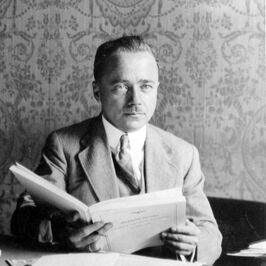
Taavi Hirvonen, Prime Minister 1914-1934.
Domestically, the 1920s was a period of peace and optimism. The new republican government was seen as a modernist force that would drive Kanadorika into a new era of prosperity. Despite the destruction that the civil war brought, reconstruction was swift. In order to ensure Kanadorikan influence in regions of the globe which had become independent during the Civil War, the Kanadorikan Commonwealth was formed in 1924 as a political association of former member states of the Kanadorikan Empire.
War would come in 1933, bringing Kanadorika into a conflict in southern Akrifa between the former colonies of Kaldesia and Ekhaya, which had proven hostile to each other since both gained independence in 1918. Kaldesia, a member of the Commonwealth, requested the assistance of other member states in 1932. Kanadorika entered the war several months later, ultimately fighting to victory alongside the Kaldesians as well as Khawsian forces. While the Kaldesian War was not particularly bloody nor taxing on the Kanadorikan treasury, it did have the effect of providing experience for a generation of officers on modern warfare.
In 1934, Taavi Hirvonen was assassinated by a fledging political faction known as the Kanadorikan National Socialists Union. The Progressive Party selected Sólver Frásson as his successor. Frásson continued Hirvonen's authoritarian tendancies, however he brought the nation further to the economic left by instituting wealth redistribution policies and advocating for a universal basic income. Nevertheless, the latter would not be instituted as Frásson too would be assasinated in 1935, less than a year into office.
With the death of Frásson, a fresh election was called by Parliament. The Labour Party gained a majority in government and selected Smári Jóelsson as Prime Minister. Kanadorikan politics became increasingly isolationist at this point.
WWII
Main article: World War II
On June 7, 1940, the Empire of Radhkivkia launched a surprise air attack on the Kanadorikan naval base on St. Sabina Island. The former prime minister, the pacifist Conservative Baldvin Jósefsson, was forced to resign in disgrace, his position being taken by Keijo Sillanpää. A declaration of war was declared between the powers.
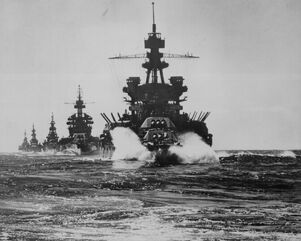
Imperial Kanadorikan Navy dreadnoughts patrol the Medietas Ocean.
The war would go on for nearly ten years, with fighting concentrated in the Nimbifer Ocean and Ezhara. Ninhundland invaded Geitland in 1941, pushing the war onto yet another front. The development of new long range bomber aircraft allowed Kanadorika to pause its island hopping campaign against Radhkivkia that had been in a stalemate despite the achievement of Kanadorikan naval supremacy mid war. The new aircraft were capable of taking off from Kanadorikan Northurland, dropping their payloads on Radhkivkia, and returning home. Massive air raids were commenced, culminating in the world's first usage of an atomic bomb, dropped on a Radhkivkian city, forcing the Empire's surrender in 1949. A subsequent atomic bomb was dropped on Ninhundland just days later, triggering a surrender on behalf of the Ninhundish government.
Post-War
Kanadorika entered the postwar world as, for a brief time, the world's only atomic power, though it was weary from nearly a decade of conflict. The government once again funded reconstruction, rebuilding the ruins of partially destroyed cities in Geitland and Oceania.
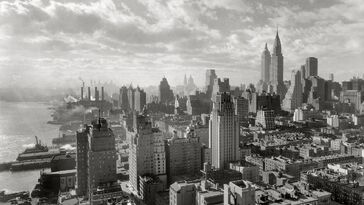
1950s Brautarhólmur
Domestic life in the post war period saw a revival to the attitudes and innovations of the 1920's. The stock market once again powered the economic superpower into prosperity. New attitudes and urban trends led to the suburbanization of locales around major cities, causing the population to migrate into the newly built suburban cities. The 1950's saw the rise of television, a powerful new tool that launched the nation into a consumerist frenzy of advertising and shopping sprees. Soon enough, it seemed the nation had completely recovered from the second world war.
In the later decades of the 20th century, Kanadorikan life was for the most part subject to a steady period of economic security. The middle class grew in size and strength, forever becoming the staple majority of the population. The far north was subject to increased financial interests, allowing for its development and population.
Rise of the People's Party
The People's Party is a Kanadorikan political party that is the successor to the prewar Progressive Party of Taavi Hirvonen. The party could trace its rise in popularity to the severe stock market crash of January 5, 2004, which drove thousands of Kanadorikans into bankruptcy. This, coupled with a rising fear of Islamic terrorism and foreign aggression, led to what Kanadorikans believed was the need for new leadership in the Parliament. As the economy continued its downwards trend, poverty and unemployment gripped what was once the most prosperous nation in the world.
The Peoples Party became the answer to the economic and political crisis that affected millions of citizens across the nation. When it won a majority in the Parliament in 2006, it nominated Kolviður Gottskálksson as its prime minister. Gottskálksson formed his cabinet, placing a young Baronet named Herja Aresdottir as the Minister of Foreign Intelligence.
Gottskálksson would die in a car crash on May 16 of 2013. Having lost its most senior figure, the People's Party deliberated for several days to decide on his successor as Prime Minister, Finally, on May 22, the party selected Herja to lead the party and the nation as Prime Minister, on of the youngest PMs in the nation's history.
As Prime Minister, Herja increased government control and regulation in the private sector. She nationalized infrastructure and other sectors of the economy to ensure that the lifeline of the Kanadorikan state was under the watchful eye of the government. Herja worked closely with the Lord Konsul to enact shared policy between both the House of Commons and the Senate.
Invasion of Terani
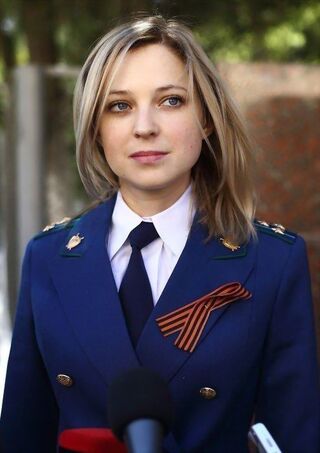
Empress Herja I
On September 26, 2015, a Kanadorikan airliner was victim to a suicide bombing attack, killing all individuals on board. The terrorist organization Islamic Union claimed responsibility for the attack and declared a war of Jihad against Kanadorika. As a result, Prime Minister Herja responded with a declaration of war against the Islamic Union, and its host state, Terani. The Kanadorikan military launched an invasion into Terani and Hajistan, decisively defeating the IU and allied Teranese and Hajistani militaries and capturing the capital city of Al-Zahalla, as well as the holy city of Syretros.
Restoration of the monarchy
At home, Herja's popularity grew immensely with the victory in the war. She was hailed as a conquering hero, successfully defending Kanadorikan national security by ruthlessly pursuing and defeating an extremist enemy abroad.
In 2017, Parliament passed a bill calling for the restoration of the Kanadorikan monarchy, which had been abolished for 99 years. Nostalgia for the institution of the monarchy was high, as the Kanadorikan Empire was looked upon fondly as the epitome of Kanadorikan civilization. The Senate created a list of possible candidates for the imperial throne, among them being Herja as well as a descendent and heir to the last Emperor, Víglundsson II. When the Senate voted on who should lead the nation as monarch, Herja was overwhelmingly selected in a manner similar to that of Prime Minister turned Emperor. She was coronated as Herja I, Empress of Kanadorika on April 7, 2017, ending the Republic of Kanadorika and forming the Third Empire.
Third Kanadorikan Empire
The Third Kanadorikan Empire should not be considered as a totally separate government from that of the Republic. Indeed, while a monarch was placed on the throne, Parliament remained unchanged, only now swearing allegiance to the Empress.
Geography, Geology, and Climate
Geography

Northern lights over the boreal forests of Northurland
Kanadorikan Eyjan exists entirely within the continent of Eyjan, and is located in the Glacialis Ocean, above the arctic circle. Eyjan is the most northerly major landmass in the world. Northurland is to the west, sharing a sea border with Inukpak. Located on the continent of Anphilos is Lappeenkoski, which shares a land border with the Union of Kuratan Socialists Republics and Noremacia. Geitland, which refers to the Kanadorikan lands in Eporan, shares a border with Treko and Ninhundland. Hajistan and Terani are in the middle east, and border each other. Gulland is on the continent of Altane. Kuwang and Huzhi are located in eastern Hezrana, south of Michu. Finally, Oceania consists of a series of Islands and atolls in the Nimbifer Ocean.
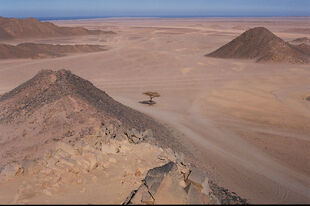
Desert of Terani

Frozen tundra of Þinnagil
Geology
Eyjan is well known for volcanic activity, as it is located on the conjuncture of three separate Teutonic plates.
On 21 March 2010, a volcano in Eyjafjallajøkull in the south of Ejyan erupted for the first time since 1821, forcing 600 people to flee their homes. Additional eruptions on 14 April forced hundreds of people to abandon their homes. The resultant cloud of volcanic ash brought major disruption to air travel across Etharia. An even larger eruption occurred on April 11, 2020, when the Hameentrish volcano Mt. Kallioinen exploded in the largest eruption in well over a century. The volcano ejected so much ash and debris into the atmosphere that the global climate of 2020 is expected to be several degrees cooler than average, leading to a shorter summer and a long bitterly cold winter.

Eruption of Mount Apitkä.
Northurland is less volcanic. The southern half of the island consists of dense forests, with agricultural fields lining river valleys and the outskirts of cities.
Climate
Government and Politics
Kanadorika is a Parliamentary monarchy in which power is vested in the Empress, and her Parliament, as well as the Prime Minister, who appoints individuals known as High Ministers to run various cabinet positions within the government.
While the Empress does hold much power in theory, in practice she does not utilize it in most daily decision making. Instead, she relies on the Parliament of Kanadorika to make and pass legislation.

Government of Kanadorika
The Parliament is an ancient legislative institution that is divided into two houses: the upper house, known as the Senate has an unbroken history going back to the Venesian Senate over 2500 years ago. The Senate is headed by a Lord Konsul, who is elected by the Senators. The current Lord Konsul of Kanadorika is Annikki Kivistö. The lower house is the House of Commons, whose history goes back to the reign of the medieval Emperor Aslak I. The House is headed by a Prime Minister. While formerly the Prime Minster was appointed by the majority party within Parliament, with the institution of the one party system, the position is now appointed by the People's Party. The current Prime Minister is Viktor Magnússon.
Nations
Kanadorika is divided into eight nations, each of which is governed by a Magistrate. While nations must comply with federal legislation, they are free to pass their own legislation and raise taxes.
| Flag | Location | Name | Population | Capital |
|---|---|---|---|---|
 |
 |
Hvidovia | 193,844,000 | Venesia |
 |
 |
Northurland | 71,250,000 | Daegu |
 |
 |
Gulland | 60,554,100 | Kambera |
 |
 |
West Akrifa | 94,000,000 | West Akrifa |
 |
 |
Kuwang | 82,310,900 | |
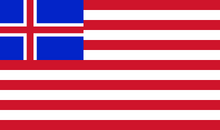 |
 |
Hameentra | 96,103,000 | Ylökaupunki |
 |
 |
Common-wealth of Oceania | 40,331,500 | Ósfjøll |
 |
 |
Leirhofn | 17,818,160 | Hapargård |
| Federal Territories |  |
1,510,000 |
Foreign Relations
The Empire holds relations with many nations across the globe. It is a founding member of the Kanadorikan Commonwealth; a committee of nations who have at one point in their history been the sovereign territory of the nation of Kanadorika.
Radhkiva
The Empire has close relations with Radhkivka, who, after WWII, had their Emperor dethroned by the Kanadorikan military and replaced by a new Imperial family. Kanadorika also serves as the only land border to Radhkiva, with the provice of New Gwangju bordering Radhkivkian Guyonji. Today, the two nations share military and economic ties, with Radhkiva under the protection of the Kanadorikan nuclear umbrella.
Treko
Treko and the Kanadorikan Empire share irregular relations. The two have been historic enemies and have gone to war many times in the past. After WWII, the two nations began warming up relations, and today, allow for free travel of Trekkish and Kanadorikan citizens into and out of Geitland.
Michu
The historic ally of Kanadorika, Michu shares centuries of close relations with both the Republic and Empire, with the two coming to each others aid in conflicts throughout history. The two nations are members of the Oriental Union.
Ninhundland
Ninhundland has been the traditional enemy of Kanadorika, with hostile relation culminating in the second world war in which the Ninhundish military invaded Geitland. After several years of combat, notably in Hallursvik, The Kanadorikan military pushed the Ninhundish back into their lands and dropped an atomic bomb on their country. Today, the hostilities have cooled, though some Kanadorikans are still distrustful of the Ninhundish.
Eladiastan
Kanadorikans hold generally negative views towards Eladiastan, with the Eladiastani Slave Trade and the Shaoliang Harbor Conflicts cited as contributing to those negative views. Officially, Kanadorika holds no official policy towards Eladiastan.
Law Enforcement and Crime
Economy
Kanadorika adheres to the economic ideology of Corporatism. It officially rejects Capitalism and Socialism, viewing those systems to be either inefficient or unjust. Instead, the Kanadorikan economy is organized into different interest groups (corporations) consisting of guilds from each economic sector. Private ownership of property is legal, though collective bargaining is utilized to ensure the needs of the workers are met.
Military
The nation's military operates strategic forces to attack hostile nations in the event of a homeland invasion, or to engage in the invasion of a foreign power. There are five branches of the Kanadorikan military; The Army (Her), Navy (Sjóher), Air Force (Flughernum), Imperial Marines (Vatnsfimi), and Revenue Marine Service. (Tekjur Sjávarþjónustunnar ). The Kanadorikan military operates on land, in the air, and in international waters. Under the country's militia system, professional soldiers constitute about 5 percent of the military and the rest are conscripts or volunteers aged 19 to 34 (in some cases up to 50). The Navy has traditionally been considered to be the most powerful navy of the world over the centuries, forming the heart of Kanadorikan military doctrine, with the Air Force playing a similar role.

Kanadorikan soldiers train in Seðissandur.
The Empire is a nuclear power, and still remains the only nation to use a nuclear weapon in warfare.
The structure of the Kanadorika militia system stipulates that the soldiers keep their own personal equipment, including all personally assigned weapons, at home. Compulsory military service concerns all male and female Kanadorikan citizens. Men and women usually receive initial orders at the age of 18 for military conscription eligibility screening. About two-thirds of young Kanadorikan men and women are found suitable for service, while alternative service exists for those found unsuitable. Annually, approximately 20,000 persons are trained in basic training for a duration from 18 to 21 weeks.
Internal Government
Government in Kanadorika adheres to the Federalist system. Power is divided among the Imperial government, national governments, the cantonial/provincial governments, and local governments.
Most cantons are further divided into counties, which may be issued a degree of authority by the provincial government. Nevertheless, they are not sovereign, and must comply to both provincial and
Nations
Nations are regions within the Empire which are home to a large and distinctive culture. The dominant language of a nation will generally be recognized as an official language of Kanadorika, and each nation with the exception of Leirhofn and Hvidovia (they share the Kanadorikan language) do in fact have distinct native tongues.
There are eight nations within the Kanadorikan Empire: Hvidovia, Leirhofn, Hameentra, Northurland, West Akrifa, Oceania, Kuwang and Gulland . Three of the nations have their own royal families and monarchies who administer their kingdoms. Oceania, Hvidovia, Kuwang, West Akrifa, and Gulland do not posses monarchies and instead are under the direct authority of a national prime minister. The nations themselves are semi-sovereign; bound to the decrees of the Empress and federal government, however for the most part are self administered, as the government does not interfere much in localized politics and management.
All four of the monarchies are hereditary, using the system of absolute primogeniture to determine the heir to the throne, similar to the imperial throne.
Cantons
Demographics
The population is estimated at 530,817,500
Racial Composition
Because of its existence as a global empire, Kanadorika is home to Etharians from a multitude of backgrounds. While being dominated by peoples of Eyjanic heritage, Kanadorika holds a significant minority of Radhkivkian, Trekkish, Ninhundish, and Michise groups. In West Akrifa, Akrifans the majority, whereas Nimbifer islanders and ethnic Hvidovians live in equal numbers in Oceania. A small population of Inuit natives live in Northurland.
Religion
According to the most recent census, taken in 2005, Venesian Catholicism is the most prevalent religion in Kanadorika, as well as the official state religion, with over 90% of the population identifying as such, though 7% identified as Atheist or non religious, with the remaining 3% consisting of minority religions.
Culture
Language
Venesian was the original unified language of Kanadorika. The languages of Leirhofnian, Kánadórikan, Sauðárkurish, and Kvínsurian would evolve from Venesian, becoming distinct languages by the 8th century. Hameentrish belongs to a different language family all together. The creation of the Kanadorikan Empire made Hvidovian the official language in 1081. Over the years, Sauðárkurish and Leirhofnian would become extinct, as those respective kingdoms chose to fully adopt Hvidovian, leading to a gradual decline in native speakers. Gugtonese rose to gain the same prominence as Hvidovian, and was accepted as the leading business language of the Empire.
With the end of the Empire in 1918, the creators of the new republic kept Hvidovian and Gugtonese as the official language of the nation, and made Hameentrish an official language as well. Today they exist primarily as regional languages, though they are both taught nationwide to all Kanadorikans.
The runic alphabet is the official alphabet of the Hvidovian language.
Gugtonese is the fourth official language of Kanadorika, as well as the second most spoken.
Teranese is spoken in Terani, Whereas Haji is spoken in Hajistan.
Infrastructure
Transportation
Roadways
An intricate system of highways connects cities throught Kanadorika. Following the Second World War, the government invested in a series of interstate highway programs to thoroughly connect and provide quick and simple transportation between the cantons. Highway 40 (1953) linked the west to the east coast of Eyjan. As the years progressed, the highway system grew in size and scope.
Air Transport
The civil airline industry is both privately and publically owned, and is one of the largest airline industries in the world. As of 2014, the three largest Kanadorikan based airlines are; Lofthvidovia, Northurland Airways, and Imperial Airlines.
Rail
All of Kanadorika's network of railroads are publically owned. Contemporary Kanadorika is home to multiple highspeed railways located throughout the Empire. These include HJE, serving Eyjan, Geitlandic Railways, serving Geitland, and other networks.
Energy
Production of electricity in Kanadorika is a state operated sector. Nuclear power contributes to the vast majority of the nation's power generation, followed by geothermal, hydroelectric, and natural gas. In recent years, there have been both private efforts and governmental concerns to reduce pollutants output in the nation, leading to a push for cleaner energy. Nuclear fusion is being researched and developed by scientists throughout the nation, it is not expected to become a viable energy source within the next decade. Coal burning plants were phased out during the environmental concerns of the 1970s, and now only constitute a small percentage of energy production. The trend towards renewable energy has encouraged the development of solar and wind farms in the central cantons.
